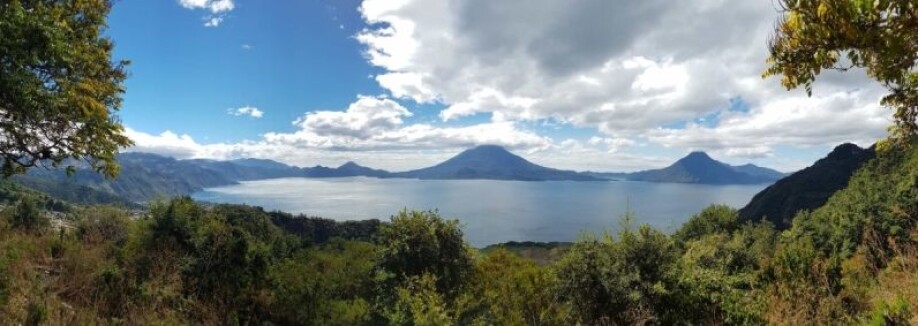THIS ARTICLE/PRESS RELEASE IS PAID FOR AND PRESENTED BY University of Oslo - read more

Supervolcano eruption can change the periodic wind system in the tropical stratosphere
The question of what happens in the atmosphere when a supervolcano erupts, has concerned scientists in atmospheric chemistry and meteorology for a while.
Now, a research team from UiO, GEOMAR, NCAR, and MPI-M have worked together and come closer to an answer. They present their new findings in the journal Geophysical Research Letters.
The object of their interest happened ∼75,000 years ago in the Guatemalan highlands – the supervolcano eruption Los Chocoyos. Today, the eruption site is an enormous caldera, the Atitlán Caldera (14.6°N, 91.2°W). The caldera, now a lake, lies about 1,563 metres above sea level, fringed by three cone-shaped volcanoes: Atitlán, Tolimán, and San Pedro.
When the volcano once erupted it had the magnitude of eight, the highest ranking on the Volcanic Explosivity Index (VEI).
“The most beautiful lake in the world”
The German explorer and naturalist Alexander von Humbolt (1769 – 1859) called it 'the most beautiful lake in the world' (Wikipedia). The beauty of Lake Atitlán is well known, and today it is one of the landscape highlights in Guatemala, and a national and international tourist attraction. It is surrounded by small Mayan villages.
Despite the volcano now being dead, the caldera gives evidence of the power the eruption had in the past, recently described in a study: A history of violence: Magma incubation, timing, and tephra distribution of the Los Chocoyos supereruption (Atitlán Caldera, Guatemala) by Cisneros et al (2021) in Journal of Quaternary Science.
The eruption is known as one of the largest volcanic events of the past 100,000 years, and must have been an inferno of magma, explosions and outburst of gases.
Release of chemical components to the atmosphere
Analyzed samples of deposits in geological layers after the event show that when the eruption happened, it also emitted enormous amounts of sulfur, chlorine and bromine to the atmosphere. Volcanic ash after the Los Chocoyos outburst is found several places in the Guatemalan highlands and in marine deposits from deep-sea cores in the Pacific, the Mexico Gulf and even in the Atlantic Ocean.
The research team had the hypothesis that such large emissions from the outburst would cause multi‐decadal consequences to the atmosphere and the global climate. But for how long? And what strength and volume would the emissions have?
To get any further on these questions the research team had to use simulation models that represent today’s knowledge of the climate system. With this approach, it allowed them to simulate the impact of a Los Chocoyos‐like eruption, and the effect of huge amounts of emissions to the atmosphere (Brenna et al 2020 ACP).
Long lasting disruption of zonal wind system
Of special interest was the effect the emission would have on the quasi‐biennial oscillation (QBO), an alternating change of every other year of zonal wind directions in the stratosphere in the tropics. The stratosphere is the second layer in the Earth’s atmosphere from approximately 15 to 50 km altitude.
“An eruption at this dimension would supply amounts of aerosols and chemistry components to the atmosphere, and according to our model simulations, the eruption would cause an approximately 10 year long disruption of the QBO wind,” says Kirstin Krüger, author of the study.
“The change in the QBO would have started 4 months post-eruption, with abnormal easterly winds lasting ∼5 years, followed by westerlies wind, before it returned to normal QBO conditions, but with a slightly prolonged periodicity.”
This disruption of the wind system is a result of heating of air caused by aerosols, and a cooling effect caused by ozone depletion after the eruption. This heating vs. cooling interact with the propagation of atmospheric waves and evolved to disrupt the QBO.

A geological event with large impact
The researchers tested out the scenario of emissions on different model ensembles, and on different volcanic forcing scenarios. The results of these supplementary studies verified the first results. They also repeated the simulations with a second model, which also backed up the robustness of the first results.
The new study in Geophysical Research Letters sheds light over what happens when such a supervolcano erupts. It would last several years, the emissions will have a peak, and it can have power to temporarily change the wind regimes in the tropical stratosphere.
Supervolcanos of today
Today it is approximately 20 supervolcanos around the world. One of the most famous is the Yellowstone Caldera in the USA. Yellowstone is known to have had two VEI 8 eruptions in the past (some 2.1 million and 640,000 years ago).
References:
Hans Brenna et.al.: Decadal Disruption of the QBO by Tropical Volcanic Supereruptions, Geophysical Research Letters, AGU, 2021.
Hans Brenna et.al.: The potential impacts of a sulfur- and halogen-rich supereruption such as Los Chocoyos on the atmosphere and climate, Atmos. Chem. Phys., 2020.
Alejandro Cisneros de León et.al.: A history of violence: magma incubation, timing, and tephra distribution of the Los Chocoyos supereruption (Atitlán Caldera, Guatemala), J. Quat. Sci., 2021.
See more content from the University of Oslo:
-
Queer opera singers: “I was too feminine, too ‘gay.’ I heard that on opera stages in both Asia and Europe”
-
Putin’s dream of the perfect family
-
How international standards are transforming the world
-
A researcher has listened to 480 versions of Hitler's favourite music. This is what he found
-
Researcher: "AI weakens our judgement"
-
New, worrying trend among incels, according to researcher





































